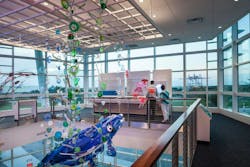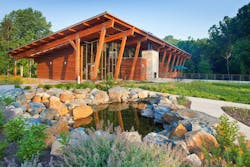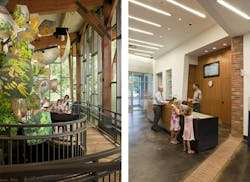Achieving an ideal visitor experience with the ADROIT approach
Through over 30 years of designing interpretive centers, I’ve found that the most significant experiences are created through a close collaboration between architects, landscape architects, and exhibit designers. Inherent in that process is incorporating the most logical visitor sequence. I use the acronym ADROIT when describing that sequence: Arrival, Decompression, Reception, Orientation, Interpretation, and Transformation.
What is the ADROIT Approach?
Arrival
Arrival is the first impression of a place or site. Ideally, one sees their destination prior to parking or disembarking other forms of transportation. In doing so, the stress associated with trying to understand and navigate in an unfamiliar environment is minimized (see intuitive wayfinding).
Decompression
Decompression is the journey between arrival and actually entering a building or site. This phase allows time to cleanse one’s mind of their trip or daily stresses and prepare for their visit. Effective decompression happens over a meaningful amount of time and distance and ideally incorporates some initial interpretation. Often, clients are conflicted about the idea of decompression and the need to accommodate the disabled or elderly. While these are important considerations, more often than not, solutions can be found without sacrificing the opportunity for decompression.
Reception
Reception is the formal entry to the resource and should be visible upon arrival. Reception may be as simple as a sign at a trailhead or park, or in the case of a building, a lobby, or welcome desk. If possible, this area should be operated by someone qualified to answer any questions one may have before their interpretive experience.
Orientation
Orientation provides visitors with an understanding of the opportunities available to help plan their visit. In the case of a natural site, orientation is typically limited to a map of trails and destinations, with information such as distances, terrain difficulty, etc. Conversely, in a large visitor center, orientation is often multifaceted, including maps, interactive touch screens, orientation films, and access to staff for specific questions. Regardless of the vehicle, proper orientation is critical to a comprehensive and enjoyable visit.
Interpretation
Interpretation overarches the entire visitor experience and should begin the moment one enters the site. It is accomplished through a variety of vehicles and venues that range from simple two-dimensional displays to interactive exhibits and 4D theater experiences. In the case of living history sites or museums, messages may be delivered via costumed interpreters or docents. The most effective interpretation includes a rich mix of strategies to reach the broadest possible audience.
Transformation
Transformation is the ultimate goal of the visitor experience. Successful visitor and interpretive facilities do more than provide information; they touch people on many levels, allowing them to make personal connections to the subject matter and inspiring them to learn more. Imparting that knowledge and an appreciation of the resource(s) clearly and memorably is the key to transformation.
Visitor experiences are a significant component of lifelong learning and provide many opportunities to impact one’s life. To make that experience as enjoyable and stress-free as possible requires an ADROIT touch.
About the Author
Alan Reed is GWWO’s President and Design Principal. He is a regular speaker on topics related to interpretive center design, including contextual design, and in 2011 he was elevated to the AIA College of Fellows specifically in recognition of his work on interpretive center facilities nationwide.



